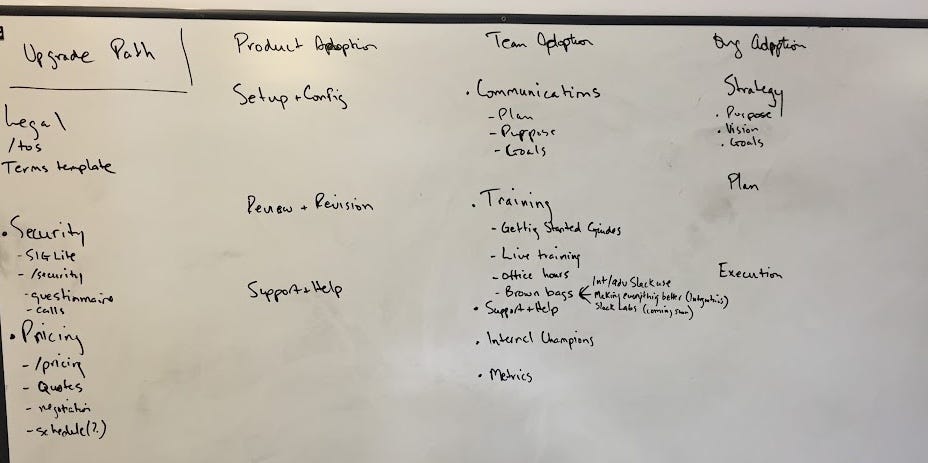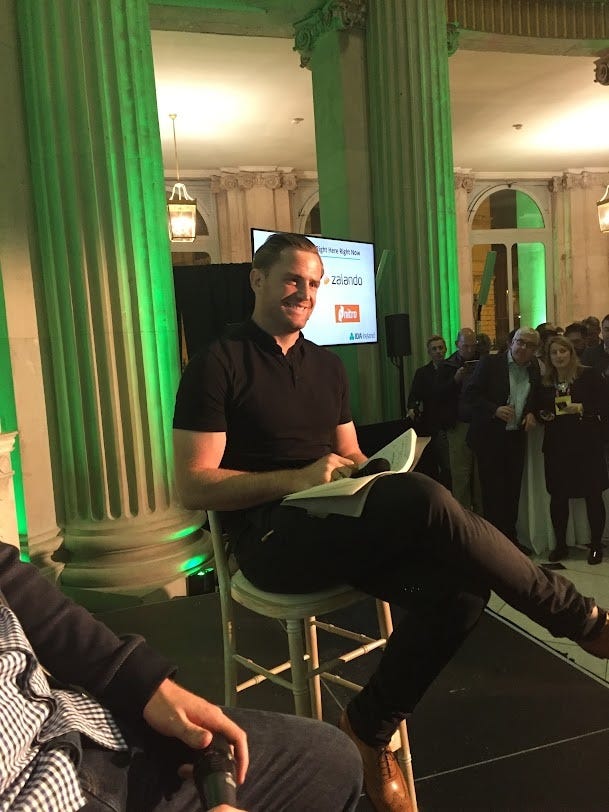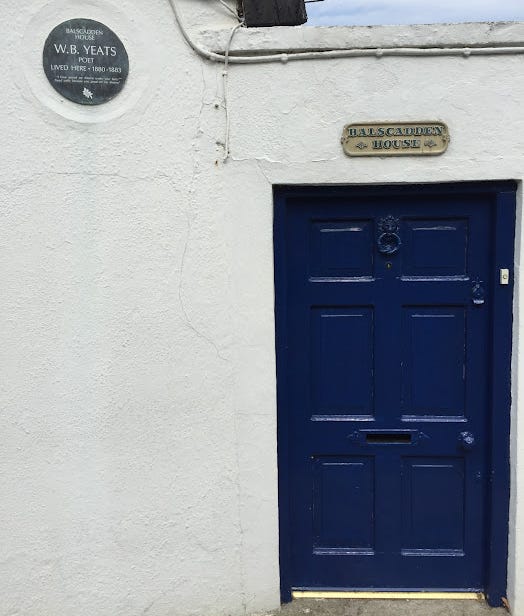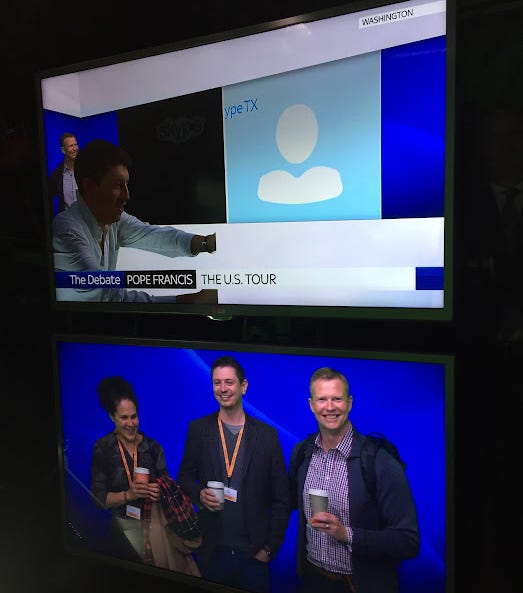Hiring Good Irish Hybrids
Hiring all the time. Selling Slack to candidates. Adapting Slack to Ireland. Guessing that it's a little from column A, a little from column B.
When I started in Dublin our team at Slack consisted of 3 people. When I left Dublin 27 months later our team consisted of 62 people. In the 567 work days between my arrival and departure, we needed to hire, a lot — more than 2 new people per month, without losing anyone.
More than 2 new people per month meant a ton of upstream work to make that pair of hires — recruitment, screening, reviewing, interviewing, scoring, checking references. Depending on the day, somewhere from 30-50% of my job focused on the broad process of hiring people. My #1 job was selling Slack to customers. My #2 job was selling Slack to prospective new employees.
And to find the right candidates we had to run a broad campaign of awareness. Through recruiters, events, media, friends, contacts and, best of all, existing employees, we eventually found great people. But not right away. Right away in Dublin we got a bit lucky. Then we hit a wall and had to build our recruiting muscles.
It was just like Sales in Europe, it was Just Like Starting Over. But for recruiting, the sale went both ways. Candidates had to sell us on them too.
Selling Slack to Candidates
At first it seemed like introducing candidates to Slack would prove pretty easy. An entrepreneurial energy filled the air. The candidates we met seemed ready to take risks. Tons of US-based tech companies occupied Dublin’s cobbled, winding streets. We were just one of the newest of the Johnny come latelys.
They had the Internet in Ireland and some excellent candidates awaited us. Plus, we made assumptions that provided a shortcut. We started our hiring by transposing the same hiring process I’d created in Vancouver. I wrote about the process in How Slack Hired its First 5 Sales People.
In short:
Candidates we thought had promise got a half hour screening interview over the phone.
If they moved ahead, they got a written assignment.
If they moved ahead, they got a presentation assignment.
If they moved ahead, they got an in-person interview.
If they moved ahead, we did references checks.
We used the same scorecard at each stage to decide on candidates progressing or getting declined.
And that worked for the first two folks who joined us: Alia and Paul. They both knew they wanted to work at Slack right away. It proved a simple sell and an easy landing. It got us started.

First was Alia Lamaadar. As she told me in our first conversation, her name was 60% As. She was an incredibly dynamic and intelligent and driven person. So much so, that she found us. Before we had an open position in Dublin on our website, she found me and started courting Slack. She was on top of it. She was also Canadian, so I felt a certain amount of familiarity with her. She knew Mr. Dressup. She understood what it was like to not be American but be able to pass for American. To get asked if she was an American, to say she was a Canadian, then to get asked, So what’s up with your man Trump?
Paul Murray showed up next and I loved how he ran his candidacy as a sales process. He identified leads as places he could get a job. He qualified them. He focused his search on top prospects and then worked those prospects so they turned into opportunities. He tracked the stages of the opportunity as it progressed or as it qualified out. I could practically see the spreadsheet he was keeping behind the scenes to track it all. I appreciated it and Paul joined up.
But then our hiring process didn’t work. We hit the wall. We still got occasional good candidates, but most folks ended up qualified out pretty quickly. We worked with recruiters to increase our flow of candidates and the folks we got were okay. But overall they also felt very mercenary. Something needed to change and fast.
But convincing candidates to choose Slack as their number one employer was harder. They had oodles of choices. The folks we met, especially early on in our Dublin journey, seemed a bit skeptical and aloof. The entrepreneurial spirit worked against us. They didn’t know Slack. They didn’t know of Slack. They didn’t use Slack. They didn’t know anyone who worked for Slack.
The numbers we rattled off from our fact sheets sounded impressive, when we got the chance: millions of dollars raised, a billion-dollar valuation, name brand customers, growth rates we still measured week over week. But those facts slid over people without making much of an impression, like facts so often do.
So we had to really work to find candidates and tell them our Dublin story, because it needed to be different from our American story. But we didn’t know that yet. Or, we didn’t maybe want to take on the responsibility for that yet.
Adapting Slack to Ireland
To make headway, we had to take a step back and see Slack through a prospective candidate’s eyes. Sure, it looked promising. Headlines and backers and customers all shone brightly. But our office was a tad grotty and in a deeply unique neighbourhood.
The signals people used to triangulate the status and quality of us as a prospective employer all felt a bit fuzzy. Prospective candidates outside of our core tech geek community had questions and we struggled to provide compelling answers. We found we needed to paint a compelling picture of the future, and how a candidate could be part of that scene.
Just like every game for a sports team is different and the same — different in its circumstance, the key plays, the players and their roles; the same in its general rules, the tactics that mostly lead to success, the need for individuals to pull together and put the team first — every hiring process we ran felt different and the same at once. And we found we had to start stacking up some small wins at a very local level to start to make progress.
Did we increase our candidate flow? Did we have enough candidates moving through the pipeline? Did we close every candidate we wanted to close? The more I got to know the ins and outs of recruitment, the more I found it mirrored the business-to-business sales process. These could be our wins.

We kept using recruiters and we started to provide them more feedback to tune their antennas to what we sought in candidates. We challenged them and they got better. We started to do more local PR and events. Word got out. We found more pockets of tech geeks and those communities connect us to other communities. We got noticed.
I can recall two specific tactics that seemed to work best:
Targeting specific people who already had jobs, reaching out to them and asking them to consider Slack and a specific open position we had and;
Asking all our existing employees for referrals to their friends and former teammates who they might want to work with again.
And so our snowball started rolling and we picked up some momentum.
Alison McPhail’s interview felt like a tale of two people, and consequently two prospective employees. In both, she was young and didn’t have a ton of experience. And at first, she was capable but quiet, reserved and then effusive in glimpses. Finally, as we kept talking, she opened up and we got to know her, and it became clear she could become a star. We hired her and she did.
Bernie Carroll came through a recruiter and nailed everything right from the start. Nailed it. She knew the job. She was already doing it at LinkedIn. It took zero imagination to see her working for Slack and knocking it out of the park. She was driven and focused and she could teach us things about how we should run Slack. Yes, please.
Niall Horgan played hard to get. I went to meet him in his office because he clearly had talent and energy and was going to succeed. Except he worked in media sales at Twitter, so moving to software sales at Slack felt like not an ideal transfer of industries, and visiting him at Twitter EMEA HQ felt like going behind enemy lines.
And if I’m honest, Niall was a bit prickly too — interested, sure, look, but also working a few angles. Would Slack become one of them? Could be. He had a few irons in the fire. Lots of opportunity out there. He went quiet for a few weeks. Then, okay, sure, like, he came back and decided he would be delighted to join. Niall lent his charisma and diligence to Slack for a few years before shifting full time to pursue his ambition running his own clothing company, Gym + Coffee.
Panos Karantais was a risk to hire. He was coming without a sales background. He had worked in software for some great companies, but mostly supporting customers after they were already customers. Could he also win new customers? He spoke so many languages (5? 6?), certainly that would be a great asset too? Yes and yes. He joined and proved a terrific contributor to both our business and our culture.
Remembering all these folks now takes no hard work at all — they were all memorable and excellent and both me and Slack lucked out hiring them. The only challenge is being accurate in recalling where we all started together, in such very modest circumstances, because all the members of the team quickly progressed far beyond where they started.
A little from column A, a little from column B
Were these folks going to succeed wherever they worked? Probably, yes.
Did they succeed more at Slack because of the way we did things, the open context they were put in, the momentum of the company? Also, probably yes.
Both were ingredients and played a part. These folks formed the basis for Slack’s sales efforts in Europe. They did the work every day. They went on to hire more folks. They closed the deals, they set the pace, they established the culture.
I recognize this may sound like a broken record by this point in the story, but truthfully the single thing that made the experience at Slack remarkable was the people. Some alchemy of their talents and hard work, and the situation they found themselves in and the times we shared made for an incredible place to work. And I’m missing people too.
It wasn’t perfect though. To paraphrase Mark Twain: Good decisions come from experience, and experience comes from poor decisions. Somehow we didn’t really know what we were doing. We got started though. We changed our approach quickly and then we did a great job with the new approach. We kept learning. The people at Slack made that all possible.
I mentioned how directly after our splashy launch event at the Long Room at Trinity College Dublin’s library I walked to a pub called The Long Hall, and that walking with me was Ciaran Chaney, who was applying to be Slack’s workplace manager overseeing all our offices and real estate in Europe. The walk was our interview.
I’ve mentioned how weaving in and out of people on the narrow sidewalks of central Dublin I tried to get a sense of Ciaran’s experience, what he might bring to the job, his capabilities. Did I interview him well? No. Did I know his job? No. Did I know what it might take to succeed in it immediately, then grow into its increasing demands over the following years? Also no. I was pretty clueless.
So I focused on getting to know Ciaran. Was he trustworthy? How did he react when stressed? When had he failed and what had he learned? How did he ask for help? How did he keep working to do the right things with minimal guidance and against substantial resistance and doubt?
By the time we arrived at The Long Hall I didn’t know if Ciaran could negotiate a lease or push a landlord or get excellent pricing on furniture and fit outs. But he seemed like a good egg. He had the energy to push ahead. He was honest and conscientious. Doing good work mattered to him and I wanted him on our team.
Was that hiring process scalable and repeatable and tight as a drum as we hoped? Not a chance. Did we share a pint? We may have. In those early days of figuring things out there was no map. We just had to do our best to figure them out, and get on with it. So that’s what we did.
Ciaran became a central presence of Slack Dublin and then Slack EMEA. He moved us to flashy new offices across from the Iveagh Gardens, where I’d previously visited Twitter and Dropbox, behind enemy lines. He opened our London office and then moved it to a glorious former BBC Radio studio. He became a key contributor running things behind the scenes, like so many. Now we could signal our success to prospective and existing employees.
But once more, I’m getting ahead of myself. We’ll get there.
Up next: A Very Stewart Visit to Dublin — Bossman comes calling. Wanting to show our set up success. Meeting his handlers. Celebrating back to the future.





